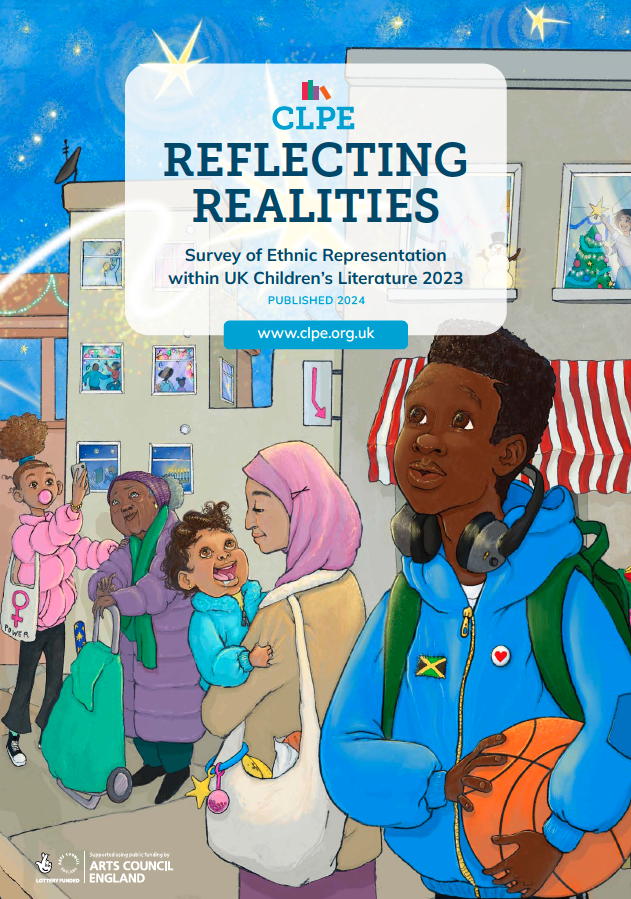You are viewing your 1 free article this month. Login to read more articles.
Neglecting realities: CLPE reports ‘stark’ drop in representative children’s books
CLPE has revealed that the percentage of racially-minoritised characters and protagonists in children’s titles dropped in 2023 for the first time since reporting began.

Caroline Carpenter is children's editor and deputy features editor at The Bookseller magazine, where she also chairs the YA B...more
The number of UK children’s books featuring racially-minoritised characters almost halved last year compared to 2022, the 2024 Reflecting Realities report from the Centre of Literacy in Primary Education (CLPE) has revealed.
The annual survey—which aims to quantify and evaluate the extent and quality of ethnic representation and diversity in UK children’s publishing—showed that just 17% of the children’s picture books, fiction and non-fiction titles published in 2023 for primary school readers featured racially- minoritised characters, compared to 30% in 2022. CLPE also found that the percentage of UK children’s books published in 2023 with a main character from a racially-minoritised background halved year-on-year to 7%. This is the first time since the report was launched in 2017 that the percentage of representative titles and main characters from racially-minoritised backgrounds has dropped.
According to CLPE, 5,884 titles published in the UK in 2023 were eligible for the Arts Council-funded report, which considers picture books, fiction and non-fiction titles aimed at three to 11-year-olds. Publishers were invited to submit their eligible books featuring racially-minoritised characters to the study, which this year totalled 999 (representing 17% of the overall output). These titles were then reviewed by the Reflecting Realities team. The drop in the fiction category—the first since this research began—was the most notable, as only 11% of titles published in 2023 featured racially-minoritised characters compared to 24% in 2022. In non-fiction, there was a decrease for the second year in a row, with 22% of titles featuring racially-minoritised characters compared to 30% in 2022. Picture books were the only text type to show an uplift, with 55% of picture books published in 2023 featuring racially-minoritised characters compared to 52% in 2022 (though this is still lower than the high of 61% seen in 2021).
Of the 999 titles reviewed, 77% featured racially-minoritised characters that influenced the narrative in their expression of thought, voice or action. Meanwhile, 16% featured a main character who spoke about their ethnicity and whose ethnicity formed the basis of a plot point, a figure that continues to remain relatively static compared to previous years. The number of secondary and sidekick characters from a racially-minoritised background was proportionate to the number of main characters. While the proportion of books submitted that featured a multicultural cast of characters with shared agency was much lower than last year at 16% compared to 27%, the report states that this felt “indicative of a shift in casting formats and text types featured in the submissions”. The number of titles submitted that only featured the presence of racially-minoritised people in the form of background characters was up from 25% in the last cycle to 32% in 2023.
The report work was led by CLPE’s research and development director Farrah Serroukh in consultation with a steering committee of leading experts in publishing and education, including: Dr Darren Chetty, lecturer at University College London; Karen Sands-O’Connor, visiting professor of education at the University of Sheffield; Dr Fen Coles, co-director of Letterbox Library; Melanie Ramdarshan Bold, professor of youth literature and culture at the University of Glasgow; and Dr Zaahida Nabagereka, senior social impact manager (Lit in Colour) at Penguin Random House.
Serroukh described the drop as “very stark”, but added that it was “not necessarily surprising”. She explained: “Since the first year, there has been steady incremental growth and with every year we’ve been pleasantly surprised that that has been the case. We thought it would take time to move from that original figure, so we weren’t anticipating a sustained upward trajectory.”
The report speculates that one reason for the dip was “the result of possible complacency”, explaining: “Historic patterns would suggest that responses to advocacy in this area are cyclical in their nature and with every period of advancement an inevitable dip is likely to follow, reducing increased presence to a trend as opposed to an embedded standard.” It also asserts that the drop in representative titles could be related to the distance from 2020, expanding: “We reported the highest overall increase in the sixth year. The seeds of these books will have been sown soon after and in response to the murder of George Floyd... The gains combined with a shift in the zeitgeist can lead to the assumption that the work is done.”
Every year, the Reflecting Realities report includes recommendations for the industry to consider. This year’s recommendations are less concerned with the content of books and instead focus on the publishing process. “If you’re invested in producing inclusive literature, then it’s not sufficient to be solely invested in the idea of it,” said Serroukh. “There has to be consideration around the journey of a book. You have to back that investment at every stage through time, through money, through infrastructure and through promotion.”
Despite the “sobering” top-line statistics, Serroukh called on publishers to read the report in full for a broader picture. “In relaying the findings, I spend much more time deliberating about the ‘why’ than I do about the numbers themselves, because the numbers are just markers. What matters is the substance of what’s being produced.” She highlighted the progress that has been achieved in the past seven years, including “amazing innovation in non-fiction in terms of not just the content that’s being explored, but also the ways in which that content has been explored” and a wider range of novels centring characters of colour across all genres. She also praised the increased platform in picture-book publishing for creatives of colour and the resulting “distinctive and varied styles of illustration and stories coming through”.
Serroukh hoped that publishers reading the report would not “become despondent or disheartened by the figures, but actually take the time to use this as a point of reflection”. She continued: “It would be a real shame for the industry to roll back, because I think it would ultimately compromise the literary quality of what we’re seeing. People might view representative literature as an additional or niche thing—something that you wheel out for Black History Month or a particular festival—but what the last seven years has shown us through the exemplary titles that have come through is that if you invest in inclusive and representative literature, it transforms the creative space in a profound and very sophisticated way.”
Ultimately, she said of the potential response to the survey: “I think it’s really important that we use this as an opportunity to stop and take stock, and then think more deeply about what we’re doing and how we’re doing it.”
Read the report in full on the CLPE website.
Read the responses from some members of the CLPE Reflecting Realities steering committee here, statements from industry professionals here and a Q&A with Jasmine Richards here.


















